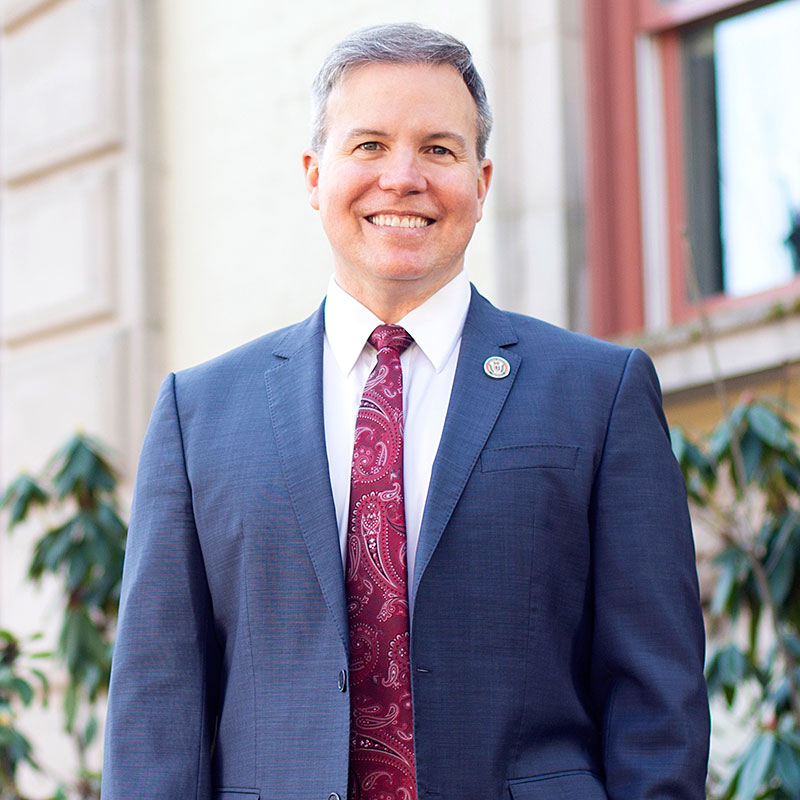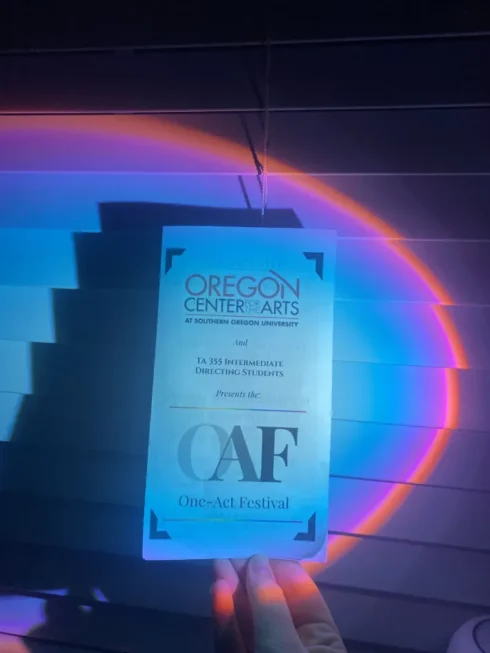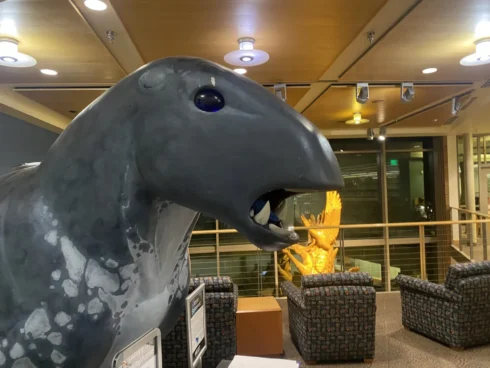The ASSOU Town Hall this past Thursday, February 2nd started off with a brief message from President Bailey surrounding the event that occurred in the Psychology building the day prior, ending with an apology from the university.
The meeting focused on the Realignment Plan, with President Bailey detailing SOU’s fiscal structure. He discussed the increasing cost curve for the SOU budget, and rather than increase tuition costs 12-15% each year, he suggests new, entrepreneurial ways for the university to increase revenue and maintain student retention on campus. As the university works on ways to increase revenue, they will also cut down their spending; faculty and staff will be cut within the next few years, certain school programs, and budgets for some clubs and some programs.
“The university is looking into what they can stop paying for or paying less for.” said President Bailey.
President Bailey then opened the room to questions.
Would the Realignment affect student workers in any way?
“Hypothetically, if there was a program that was no longer going to be around– or a center– and it had student employees, then the program/center would be eliminated, then I could see that impacting the students in that area. There would be an opportunity for students to move to somewhere else.” said Dean of Students, Dr. Vath.
Along with this, the funds received from the Federal Work-Study Program are the same as last year, so funds have not gone down for student workers this year.
How will SOU increase revenue? Is there a plan for retention leading students back into the school?
“The senior living facility– which is what we’re going to use Cascade Hall for– is a public/private partnership, where the university becomes a business profit sharing entity with the group.
The University Business District solves two things: every student I’ve talked to about this plan– the idea of this it’s going to help bring in revenue– every single student has said ‘That’s awesome, but we also want you to work with the city of Ashland to have businesses stay up past 8 pm,’ which leads to your retention question. One of the strategies we employ is to bring more students in and make sure the students that we do have are sure to get to the graduation stage.
The one thing that we’ve done is that analysis of students who do statistically better at SOU, the one thing they have in common is that they’re connected to some kind of core– student athletes, government, honors college, all these things where students are plugged in. How do we replicate that institution wide? I think there’s a lot of people who treat this as a commuter campus, because there’s not an environment that incentivizes them to stay. I know that if we create that environment and students stay around– at nights, on weekends– they’re going to support a student show, or concert, or athletic event, and they’re hanging around with each other and on campus– those students are more likely to graduate. All of those strategies have to complement each other.
We also need to help with the pipeline; We have brokered these groundbreaking deals with all of our K12 partners, and not just K12 in the Rogue Valley– we’ve gone up to Portland, Roseburg– and we’re now data sharing. Schools are sharing contact information for families so we can reach out, not just the students that are 3.5 and above, but 2.5 to 3.5.” President Bailey responded.
Is there risk of student programs/clubs getting reduced?
“One of the things that we honor is the shared governments that students have over the use of those fees. Those areas that are funded by the Incidental Fee or Student Fees are well established and well run by students here. Most of what Dr. Bailey is talking about the Education General Fund.” said Dr. Woolf.
President Bailey added onto the discussion of the Education General Fund.
“They [The Student Fee Allocation and the Budget Committee] have been on a parallel track with the university. When you rely on student fees for all these programs, and the size of the student body decreases, the pot [funds] is smaller. SFAC has a real challenge; there’s a smaller pot and they’re trying to figure out how to distribute it. We’ve focused most of our energy on the Education General Fund– and that’s where a lot of our employees are paid out of– but we’ve looked at places where we can drive efficiencies that affect things paid by student fees,” President Bailey said.
In reference to Bus Passes, how will the University handle the reduced allotment?
“The RVTD is under the student fee allocation committee, and we are currently reviewing the budget. We have Janelle Wilson looking at student data to see how many students utilize the subsidized cost for an annual bus pass. SFAC is open to students, with meetings every Tuesday from 7-8 pm in the ASSOU Senate Chambers.” ASSOU Vice President Julissa Taitano responded.
Has SOU considered recruitment of Veterans?
“There is an SOU graduate, Colonel Hoffer, he is the commander of the 142nd Air National Guard Wing in Portland– 1,400 people under his command. I had a chance to go up there and visit and congratulate him, but I said, ‘I bet there are people up here who might need a degree.’ To his credit, we are taking a team up there to say, ‘Tell us what you need, how do we make it easier for you to enter [university].’ A lot of those 1,400 folks are interested in bachelor’s degrees. Now the challenge is that we got to find ways for more asynchronous programming for them.” President Bailey responded.
Are the Arts at risk of being cut the most?
“We looked at how to make these decisions in a way that we’re not taking an ax to programs. The Arts are part of our identity as an Institution, and in other parts of the state, that’s all we’re known for; they equate us with Oregon Shakespeare Festival. It doesn’t mean we might not reimagine how the art programs are structured, but I think in general what you’ll see in the plan still honors the fact that this is something we very deeply care about.” President Bailey responded.
Why are we not investing in affordable housing for the students that are here?
“We have to find another way to become less dependent on tuition and State funding. The Cascade Project will not cost the university a dime; we’re not taking resources from anywhere else. Your point about available housing matters. This is something that not just SOU is thinking about. The city of Ashland is exploring how they think about housing. The City Manager and City Councilor are looking at an area south of campus, near Weisinger’s, for affordable housing.” President Bailey responded.
Why not focus attention on systems already in place to raise revenue, rather than invest in new avenues?
“I think it doesn’t have to be an either/or, it can be a both/and. Every time I have a chance to speak to a crowd at something at OCA, a theater performance, or a concert, I always start with ‘Hey, every time you [community members and guests] are here, you’re directly supporting our students and our university.’
The more we bring people on our campus from everywhere, the better. You’re right, we have to celebrate the good things that we’re doing here and make that part of our narrative moving forward, so it’s not just about ‘Here’s the new things we’re doing,’ it’s also a celebration of things that are tried and true and do well.” President Bailey responded.
After the meeting, we talked further with SOU President Bailey and ASSOU President Gariety.
“We [SOU] are one of only two institutions that have grown in enrollment for the second year in a row– that’s just the number of students in general. We also have students generally taking fewer courses– we have a statistic called Full Time Equivalence (FTE), which basically is ‘Here’s the number of students, and here’s how many overall student-credit hours are being taught.’ and that number has slightly dropped. Though we have more students here, they’re taking fewer courses, and there’s less FTE. From Fall 2021 to Fall 2022, our FTE went down a percent, while our headcount went up two percent. There are other universities in our state that have gone down more. We’re going to concentrate on all the things we need to do to bring students in and to support them to get to the graduation stage.” said President Bailey.
“We also grew in diversity, as opposed to other Oregon public universities, which ties into the cohort model President Bailey was talking about; We are able to create tight connections to help us grow and help with student retention.” ASSOU President Gariety added.
The next Town Hall meeting will be on February 16th at 9 am in the Rogue River Room to discuss the affected programs.



